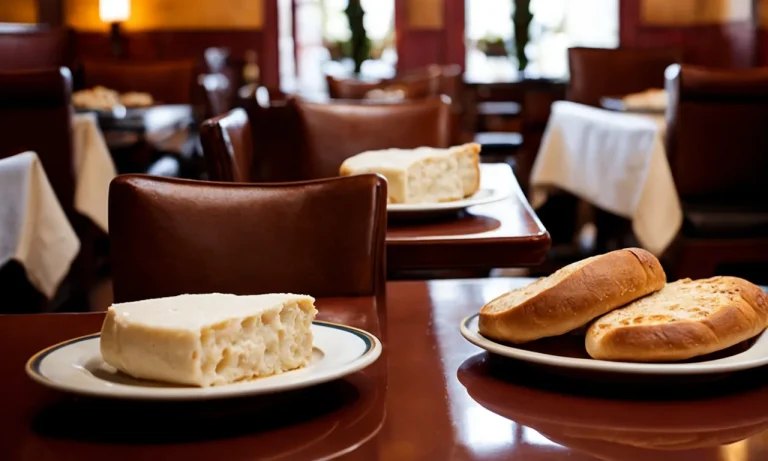Going out to an Italian restaurant but not sure what to order or how to order? You’re not alone. Italian cuisine can seem intimidating with its extensive menus and unfamiliar dishes. But ordering at an Italian restaurant doesn’t have to be scary.
With this comprehensive guide, you’ll learn everything you need to know to order at an Italian restaurant like a pro.
If you’re short on time, here’s a quick answer to your question: Understand the course structure of a traditional Italian meal, look over the menu carefully for dishes you recognize or find appealing, don’t be afraid to ask your server questions, and learn key Italian food vocabulary words to help you navigate the menu confidently.
In this detailed guide, we’ll cover how to navigate a traditional multi-course Italian meal, decode an Italian menu, identify popular and authentic dishes to try, communicate with your Italian server, order wine and other beverages correctly, and handle paying the check and tipping properly.
With insider tips and key phrases, you’ll gain the knowledge to order at an Italian restaurant seamlessly.
Understanding the Traditional Italian Meal Structure
When dining at an Italian restaurant, it’s helpful to understand the traditional meal structure. Italian meals are typically divided into several courses, each with its own unique purpose and flavor profile.
By familiarizing yourself with these courses, you can navigate the menu with confidence and enjoy a truly authentic Italian dining experience.
Antipasti (Appetizers)
The meal usually begins with antipasti, which are appetizers or small bites that whet the appetite. Italian antipasti can include a variety of dishes such as bruschetta, prosciutto, olives, and marinated vegetables.
These savory starters are perfect for sharing and enjoying with a glass of wine or a refreshing cocktail.
Primi (First Courses)
Next comes the primi, which are the first courses of the meal. These dishes are typically pasta, risotto, or soup-based and are meant to be filling. Popular choices include classic pasta dishes like spaghetti carbonara or lasagna, as well as risotto with mushrooms or seafood.
Primi dishes showcase the diversity and richness of Italian cuisine.
Secondi (Main Courses)
The secondi course features the main protein dish, such as meat, poultry, or fish. These dishes are often served with a side of vegetables or a salad. Some popular secondi options include grilled steak, roasted chicken, or pan-seared fish.
Italians take great pride in their meat and fish dishes, which are prepared with fresh, high-quality ingredients.
Contorni (Side Dishes)
Contorni are side dishes that complement the main course. These can include a variety of vegetables, potatoes, or grains. They are meant to enhance the flavors of the main dish and provide a well-rounded dining experience.
Some common contorni options include sautéed spinach, roasted potatoes, or grilled asparagus.
Dolci (Desserts)
No Italian meal is complete without a dolce, or dessert. Italian desserts are known for their decadence and rich flavors. From classic tiramisu to creamy panna cotta, there is a wide range of sweet treats to choose from.
Be sure to save room for dessert and indulge in a little taste of Italy’s sweet side.
Caffe (Coffee and Digestifs)
To end the meal on a high note, Italians often enjoy a cup of coffee or a digestif. Caffe can include espresso, cappuccino, or macchiato, depending on your preference. Additionally, you may opt for a digestif, such as amaro or limoncello, which are alcoholic beverages believed to aid digestion.
These final touches complete the Italian dining experience.
By understanding the traditional Italian meal structure, you can confidently navigate the menu and fully immerse yourself in the flavors and culture of Italy. Buon appetito!
Decoding the Italian Menu
When dining at an Italian restaurant, the menu can sometimes be overwhelming, with its extensive list of dishes and unfamiliar names. However, with a little knowledge and understanding, ordering at an Italian restaurant can be a breeze.
Here are some tips to help you decode the Italian menu and make the perfect choice for your meal.
Review the Sections Carefully
Italian menus are typically divided into sections, such as antipasti (appetizers), primi piatti (first courses), secondi piatti (second courses), contorni (side dishes), and dolci (desserts). Take your time to review each section carefully, as this will give you an idea of the variety of dishes available and help you narrow down your options.
For example, antipasti usually include a selection of cured meats, cheeses, and marinated vegetables, while primi piatti often feature pasta dishes or risotto. Secondi piatti typically consist of meat or fish dishes, while contorni offer a range of vegetable sides.
Dolci, of course, are the sweet treats to end your meal.
Look for Familiar Dishes
If you’re feeling overwhelmed by the unfamiliar names on the menu, don’t worry. Italian cuisine has many popular dishes that you may already be familiar with. Look for classics like spaghetti carbonara, margherita pizza, or chicken parmigiana.
These dishes are usually found on most Italian menus and are a safe bet for those who prefer something familiar.
Additionally, many Italian restaurants offer a selection of dishes that cater to different dietary preferences or restrictions. You can often find vegetarian or gluten-free options, as well as dishes that highlight regional specialties.
Don’t Overlook Daily Specials
While the regular menu provides a wide range of choices, don’t overlook the daily specials. These dishes are often created using fresh, seasonal ingredients and offer a chance to experience unique flavors and creations.
The daily specials are typically written on a separate board or provided as a printed insert to the menu.
Italian chefs take pride in their creativity and may showcase their talent through these specials. So, don’t hesitate to ask your server about the daily specials, as they can be a delightful surprise and add some excitement to your dining experience.
Remember, when ordering at an Italian restaurant, it’s all about exploring new flavors and enjoying the authentic cuisine. So, take your time, ask questions if needed, and savor the delicious dishes that Italy has to offer!
Choosing Authentic Italian Dishes to Try
When dining at an Italian restaurant, it’s important to choose dishes that are authentic and representative of the country’s rich culinary traditions. Here are some popular options for each course:
Popular Antipasti
Antipasti, or appetizers, are a great way to start your Italian dining experience. Some popular choices include:
- Bruschetta: Toasted bread topped with fresh tomatoes, garlic, and basil.
- Caprese Salad: A simple salad made with fresh mozzarella, tomatoes, and basil, drizzled with olive oil and balsamic vinegar.
- Prosciutto e Melone: Thinly sliced prosciutto paired with sweet melon slices.
Classic Primi Dishes
Primi dishes are typically pasta or rice-based and are served as the first course. Here are some classic options to consider:
- Spaghetti Carbonara: A creamy pasta dish made with eggs, pancetta, Parmesan cheese, and black pepper.
- Lasagna: Layers of pasta, meat sauce, and cheese baked to perfection.
- Risotto al Funghi: Creamy risotto cooked with mushrooms and Parmesan cheese.
Popular Secondi Options
Secondi dishes are the main course and often feature meat, fish, or poultry. Here are some popular choices:
- Osso Buco: Braised veal shanks cooked with vegetables, white wine, and broth.
- Pollo alla Cacciatora: Chicken cooked in a flavorful tomato sauce with onions, garlic, and herbs.
- Bistecca alla Fiorentina: A T-bone steak seasoned with salt, pepper, and olive oil, grilled to perfection.
Traditional Contorni
Contorni are side dishes that complement the main course. Here are some traditional options:
- Insalata Mista: A mixed green salad with tomatoes, cucumbers, and a light vinaigrette.
- Patate al Forno: Roasted potatoes seasoned with herbs and olive oil.
- Spinaci Saltati: Sautéed spinach with garlic and olive oil.
Remember, these are just a few examples of the many delicious dishes you can find at an Italian restaurant. Feel free to explore the menu and try something new and exciting. Buon appetito!
Communicating with Your Server
When dining at an Italian restaurant, it’s important to effectively communicate with your server to ensure a pleasant dining experience. Here are some tips to help you communicate effectively:
Ask Questions and Make Special Requests
Don’t be afraid to ask questions about the menu or make special requests. If you have dietary restrictions or allergies, it’s important to let your server know. They will be happy to provide you with information about ingredients and can often accommodate special requests.
For example, if you’re vegetarian and want to know if a certain dish contains any meat, simply ask your server. They will be able to provide you with all the necessary information so you can make an informed decision.
Be Clear About Ingredients You Want Omitted
If there are specific ingredients you want omitted from your dish, make sure to clearly communicate this to your server. This could be due to personal preference or allergies. By letting your server know, they can ensure that your dish is prepared according to your preferences.
For example, if you don’t like mushrooms and want to make sure your dish doesn’t include them, politely inform your server. They will relay this information to the kitchen staff, ensuring that your meal is prepared exactly how you like it.
Learn Key Italian Phrases
Learning a few key Italian phrases can not only enhance your dining experience but also show respect for the Italian culture. Simple phrases like “buongiorno” (good morning), “per favore” (please), and “grazie” (thank you) can go a long way in establishing a positive rapport with your server.
Additionally, learning basic food-related terms such as “pasta,” “pizza,” and “gelato” can help you navigate the menu and order with confidence.
If you’re unsure about the pronunciation or usage of certain phrases, there are many online resources available, such as Duolingo and Babbel, that can help you learn the basics of the Italian language.
By following these tips, you’ll be able to effectively communicate with your server and ensure a smooth and enjoyable dining experience at an Italian restaurant.
Ordering Wine, Cocktails, and Other Beverages
When dining at an Italian restaurant, ordering the right beverages can greatly enhance your overall dining experience. From choosing the perfect wine to pairing it with your food, as well as selecting cocktails and aperitifs, and even ordering water and other drinks, this guide will help you navigate the world of Italian beverages.
Choosing Wine
Italian cuisine is known for its rich flavors and diverse dishes, and pairing it with the right wine can elevate your meal to new heights. When choosing wine, consider the flavors of the food you will be ordering.
If you are having a pasta dish with a tomato-based sauce, a light and fruity red wine such as a Chianti or Barbera would complement it well. For seafood dishes, a crisp white wine like a Pinot Grigio or Vermentino would be a great choice.
Don’t hesitate to ask the server for recommendations based on your preferences and the dishes you plan to order.
Pairing Wine with Food
Pairing wine with food is an art, and Italian cuisine offers a wide range of flavor profiles that can be matched with different types of wine. As a general rule, lighter wines such as white or rosé are often paired with lighter dishes like salads, seafood, or white meat, while fuller-bodied red wines are better suited for heartier dishes like pasta with meat sauce or grilled meats.
However, there are no hard and fast rules, and experimentation is key. Don’t be afraid to try new combinations and discover your own preferences.
Selecting Cocktails and Aperitifs
Italian restaurants also offer a variety of cocktails and aperitifs that can be enjoyed before or during your meal. Aperol Spritz, Negroni, and Bellini are popular choices that showcase the flavors of Italy.
Aperitifs are typically enjoyed before a meal to stimulate the appetite, while cocktails can be enjoyed throughout the dining experience. If you’re unsure about what to choose, ask the bartender or server for recommendations based on your taste preferences.
Ordering Water and Other Drinks
When it comes to ordering water, Italian restaurants often offer both still and sparkling options. If you prefer still water, you can simply ask for “acqua naturale.” If you’re in the mood for something bubbly, ask for “acqua frizzante.”
Other non-alcoholic beverage options include soft drinks, iced tea, and specialty Italian sodas. If you’re looking for a non-alcoholic alternative to wine, consider trying a refreshing Italian soda made with flavored syrups and sparkling water.
Handling the Check, Tipping, and Paying
Review the Check Carefully
When you are ready to pay at an Italian restaurant, it is important to review the check carefully before handing over your payment. Check for any discrepancies or errors in the bill, such as incorrect prices or additional charges.
If you have any questions, don’t hesitate to ask the server or the manager for clarification.
Tip According to Local Customs
Tipping practices can vary in different countries and cultures. In Italy, tipping is not as common as it is in some other countries, but it is still appreciated for good service. The general rule of thumb is to round up the bill or leave a small percentage of the total as a tip.
For example, if the bill is €36, you can round it up to €40 or leave a 10% tip of €3.60. However, tipping is not mandatory, and it ultimately depends on your discretion and satisfaction with the service.
Ask About Payment Options
Before you go to an Italian restaurant, it is a good idea to inquire about the available payment options. Most restaurants accept cash, debit cards, and credit cards, but it’s always better to double-check. Some smaller establishments may only accept cash, so it’s good to be prepared.
If you have a specific payment preference or need to split the bill, don’t hesitate to ask the server or the manager in advance.
Conclusion
Italian dining can feel daunting if you’re not familiar with the menu offerings and ordering rituals. But by understanding the traditional meal structure, decoding the menu terms, communicating clearly with your server, and knowing what to expect when it comes to paying, you can order at an Italian restaurant with grace and confidence.
Use this guide to enjoy the full experience of authentic Italian cuisine, culture, and hospitality the next time you visit your favorite trattoria or ristorante.
With the tips provided here, you now have an in-depth overview on how to successfully navigate dining at an Italian restaurant. From antipasti to dolci, you’ll be ready to order like a native Italian. Savor every course and toast with a glass of vino rosso. Buon appetito!






